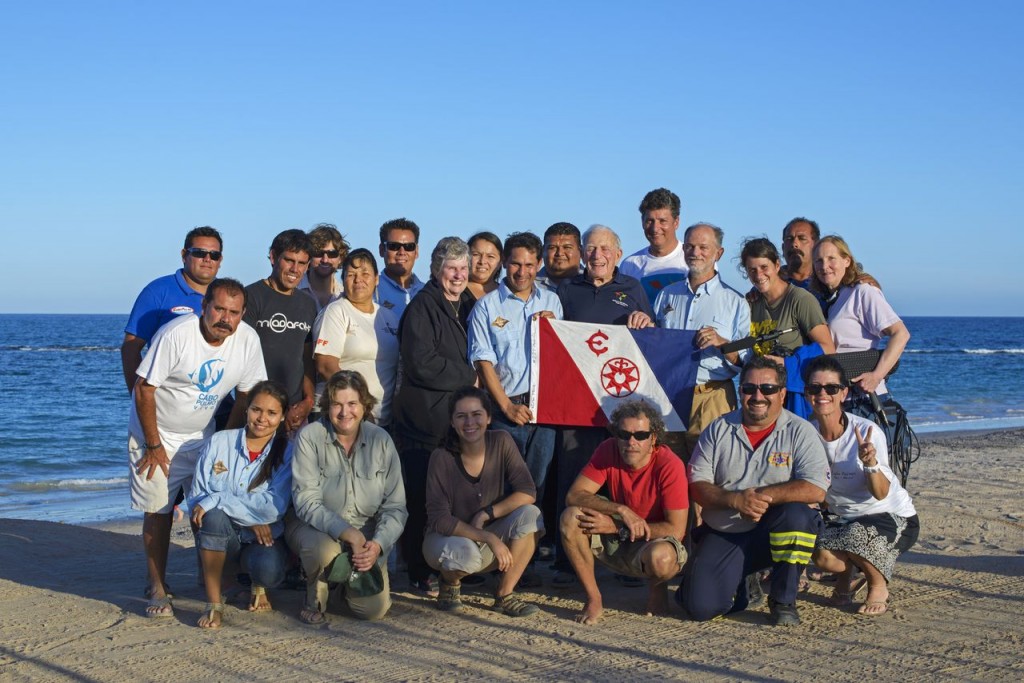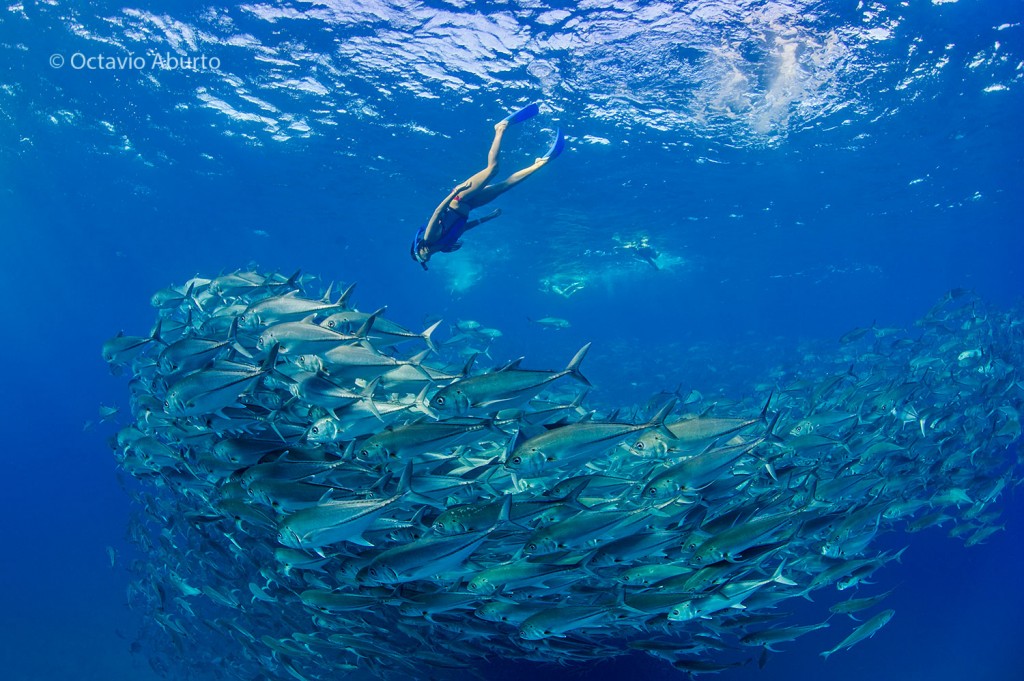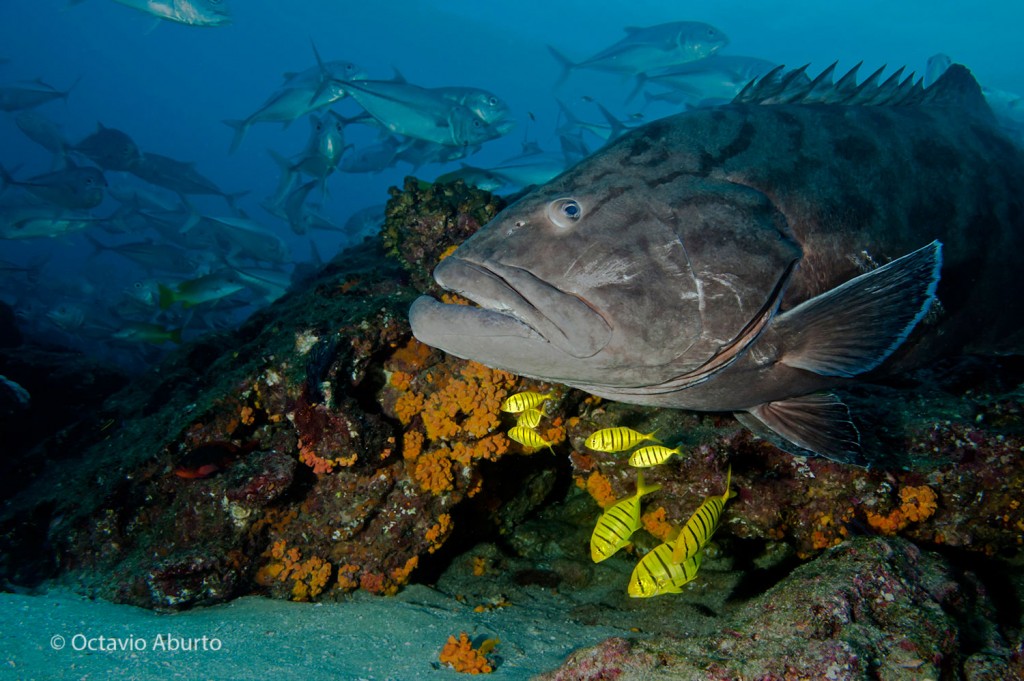Cabo Pulmo – A work in progress and a cautionary tale for the planet
May 12, 2014
For my husband Rick and me, an invitation to Happy Hour with friends led to an expedition of a lifetime. A convergence of common interests, science, and exploration took us recently to Cabo Pulmo, in Baja Sur, Mexico. A glittering oasis of plenty in an imperiled stretch of Mission Blue’s Gulf of California Hope Spot, Cabo Pulmo is a jewel in the crown of our planet’s marine reserves.
Our expedition was led by Dr. Octavio Aburto, who participated with Dr. Sylvia Earle and Dr. Jeremy Jackson on the film, Mission Blue, partially shot on location in Cabo Pulmo, and his Scripps colleagues; Josh Stewart, Brad Erisman and Tim Rowell. Rounding out the expedition were world-renowned oceanographer, Dr. Walter Munk and his wife Mary, SIO/Birch Aquarium Executive Director, Dr. Nigella Hillgarth, Dr. Giuseppe di Notobartolo, and Explorers Club Fellow, Rick Elkus. The Explorers Club sanctioned the Expedition and we were awarded Expedition Flag #221 to carry into the field.
Our mission – to study the jumping behavior of Munk’s Devil Ray or “Mobula munkiana.” Named after Dr. Munk 30 years prior, by his then graduate student Giuseppe, these rays exhibit an unusual behavior that warrants further investigation. They burst high out of the water during their mass migrations. We were honored to be in Cabo Pulmo with Dr. Munk to investigate, “Why they jump?”
Cabo Pulmo Expedition Video (c) Rick Elkus
Traveling with us was the documentary film crew of Eliana Alvarez Martinez and Andrea Swift from the esteemed New York Film Academy to help document this unique expedition. After a short flight from San Diego and 2 hour drive, we arrived in Cabo Pulmo. It sits at the end of a dirt road, isolated from the hordes of tourists that flock to Cabo San Lucas. The arid surroundings afford a natural barrier that keeps this treasure relatively untouched.
Hosted by Octavio’s friends, the Castro family that founded Cabo Pulmo three generations ago, we immersed ourselves in a daily routine that began with 5:30 a.m. breakfast and launching of the boats, a full morning on the water diving and observing, an hour break back at home base for lunch and then back on the water until nightfall.

Cabo Pulmo is a work in progress, a cautionary tale for the planet. The Castros and their peers represent generations of fishermen who made their livelihood off the sea. Talented and skillful hunters, they were so efficient that they literally fished themselves out of their jobs. 18 years ago, the current family patriarch, Mario Castro, presented a revolutionary idea. He stood up to his elders and with the support of his uncle offered the following proposition. Stop fishing, and let’s see if the fish and reefs can recover.
The Castor’s extended plan led to many harsh years of deprivation for the small community of Cabo Pulmo. The Castro family’s vision was a game changer. Give up something essential to save it. In the ensuing years, the ocean has indeed healed itself, resulting in a magnificent “Hope Spot.” Mario and his family then developed a low impact, eco-tourism business to replace commercial fishing. This aspect is key in replicating the success of the preserve. Local communities need a sustainable means of economic support to replace the fishing industry that they give up.

Much has been written about the profusion and resurgence of biodiversity in Cabo Pulmo. To experience it in the field was profound. Although our prime objective was to study the rays, we couldn’t help but marvel at the breaching Humpbacks, Dolphins, migrating Dorado and Wahoo and the spectacular schools of Jack. Jack in such large numbers that they looked like a brown reef in the distance. So many fish in a concentrated area that you could smell the fish oil in the air. Dropping into thousands of Jacks is something I will never forget. It was magical.
We did not see the mass migration (schools of 250,000+) of rays that we had hoped for. This year the water has been unseasonably warm and the ray’s food source was elsewhere. We were grateful for the use of an ultra-light and information from the regional fishermen, we were able to locate smaller schools to study and refute one hypothesis – that only males jump. It was clear that jumping rays were evenly divided between male and female. On the last day of the expedition we discovered a ray nursery and were able to study and record their unique feeding behavior.
The success of Cabo Pulmo is largely due to active protection by local fishermen. Government oversight is vital but without support from the impacted community, these projects are doomed to failure. Once MPAs are created, it is crucial that their boundaries and laws are policed and enforced. Dr. Aburto and I recently attended an international MPA conference on the invitation of fellow Mission Blue Board Member and Google Ocean Project Manager Jenifer Austin, which addressed this piece of the puzzle.

The conference brought together tech, marine biology, philanthropy, oceanography, military, law enforcement, NGOs, etc., all there to share ideas on how to work smarter on behalf of our world’s ocean and the people of the planet that depend on them for sustenance, commerce and literally the air we breathe. Enforcement of MPA Boundaries will become more standardized and cost effective as these communities align. We will bring lessons learned at Google Headquarters to help protect the community of Cabo Pulmo.
As I write, Cabo Pulmo is once again in the crosshairs of international developers. Mission Blue was among those who worked successfully several years ago to prevent developers from building an unsustainable hotel community directly next door to the preserve. The science didn’t support it and the Mexican government agreed. With a new Mexican administration leading the country, another developer is trying to resurrect the project and once again the locals and concerned global citizens are fighting to keep Cabo Pulmo safeguarded. It is my sincere hope that the Mexican government and people will continue to protect this precious resource for future generations to enjoy.

Our expedition was a success on many levels. And to the question of why the rays jump? Well, that warrants another expedition and further investigation. The research will take more time, but in Walter Munk’s own words, “Maybe they, like us, jump for the joy of it.”
Mission Blue is mounting a return expedition to Cabo Pulmo with Dr. Sylvia Earle, Sept. 24-29th. For more information contact Kip Evans. , 831-601-9402.
By Patty Elkus, Mission Blue Board Director
Feature Photo: Munk’s Devil Ray or “Mobula munkiana.” Dr. Octavio Aburto









Patty, Excellent article! Congratulations to all for an amazing expedition. Thank you for sharing such a wonderful recovery story!
Wonderful that you all are doing this field marine work, are also so attentive to conserving marine biodiversity, and that you’ve written this Blog: I applaud you all!
Here in the UK we are blessed with amazing TV series on the natural world and its multitude of wild life and I so enjoyed seeing these wonderful rays for the first time. Thank you for this experience and keep up the good work in protecting this unique habitat. Looking forward to your next visit in September
Let’s hope the new Mexican government sees this excellent article, video and photos. This is a great example of other “Hope Spots” that can be created due to replacing over-fishing with eco-tourism Well done!
— we should stop applauding scientists who warn of catastrophe and influenced politicians and bureaucrats who promote poor policies… wide-legitimate local public interest should guide any decision, not only the interests and preferences of the one family and of certain academics that obtain vast economic benefits from the reef…
Great article! can’t wait to go with you guys next time.
Excellent article Patty! Congratulations!
So I guess it’s not possible to dive here for regular divers such as myself?
Anyone can dive at Cabo Pulmo, even if you are just a snorkeller!
Here’s the kind of dive resort that Cabo Pulmo is now supporting – and it’s the right size too – SMALL! http://www.cabopulmo.com/cabo-pulmo-dive-center/
We need to slow down the marketing otherwise Cabo Pulmo is gonna get more impact with tourism like in Costa Rica !